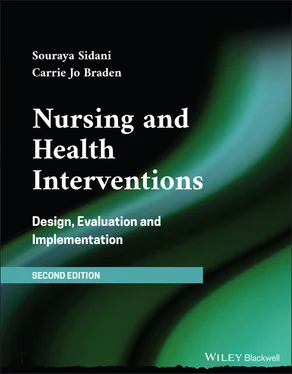2.3 CHARACTERISTICS OF INTERVENTIONS
Interventions are characterized by their elements (i.e. goals and components), which define them conceptually, and the way in which the interventions and their components are delivered. This encompasses features through which interventions' content is conveyed (Dombrowski et al., 2016) and specific components and activities are implemented. The features include mode of delivery, structure, and dose.
The mode of intervention delivery is described in terms of medium and format.
Medium is the means through which the intervention and its components and respective activities are carried out. Medium is defined by the intersection of person‐dependency and method. For the former, medium can be classified as person‐dependent and person‐independent (Beall et al., 2014; Cutrona et al., 2010). In the person‐dependent medium, individuals, including health professionals and/or laypersons, offer the intervention to clients, whereas these individuals are not directly involved in the intervention delivery in person‐independent medium. There are two methods of delivery: verbal/oral and written.
Format refers to the specific technique used within the verbal and written method for providing the intervention. Examples of specific media illustrating the intersectionality of person‐dependency, method, and format are presented in Table 2.3.
Different modes can be used to deliver different components of an intervention and more than one mode can be used to deliver each component. For instance, the sleep education and hygiene component of the multicomponent intervention for insomnia can be provided via the combination of: (1) formal presentation of pertinent content by a health professional to a small group of persons with insomnia, complemented by a slide presentation; (2) involvement of persons in a group discussion to clarify the information; and (3) a booklet summarizing the key points that serves as a reference for persons carrying out the sleep hygiene recommendations.
TABLE 2.3 Examples of specific media for providing interventions.
| Method |
Person‐dependent |
Person‐independent |
| Verbal |
Face‐to‐face formatLarge group presentationSmall (6–10 persons) group meetings/sessionsIndividual meetings/contactsDistance formatTelephone callsVideoconferencingDigital media contacts |
Recorded (audio/video) presentationsAutomated telephone callsMessage disseminated via media (radio, television, mobile telephones‐text messaging) |
| Written |
Slide presentation |
Posters located in public placesInformation distributed via diverse modes (e.g. regular mail, electronic mail, mobile telephones)Information available via digital media (World Wide Web, mobile applications, portable media players) |
Structure has to do with the approach and sequence for providing the intervention components. Approach represents the manner in which the intervention is given. It can be standardized or tailored/adaptive.
The standardized approach consists of giving the same intervention components, in the same mode, to all clients, regardless of the relevance of the intervention's components, activities, and mode of delivery to the characteristics and preferences of clients. The tailored approach involves customizing or individualizing the intervention to the characteristics and preferences of clients (Mannion & Exworthy, 2017). It is conceivable to provide some components and respective activities in a standardized approach and others in a tailored approach. In the example of the multicomponent intervention for chronic insomnia, the instructions of the stimulus control therapy are applicable to all clients and, thus, relayed in a standardized approach; however, setting a regular sleep–wake schedule, which is the specific component of sleep restriction therapy, is informed by clients' sleep needs and negotiated to suit individual clients' life circumstances.
The components comprising the intervention can be provided simultaneously or sequentially. Simultaneous provision implies that the components and respective activities are presented, discussed, and carried out all together at one point in time. For instance, Sidani et al. (2019) designed the multicomponent intervention for chronic insomnia in a way whereby the information and recommendations of the sleep education and hygiene, stimulus control therapy, and sleep restriction therapy were conveyed to clients in the first intervention session; clients were instructed to apply all recommendations associated with these three components simultaneously.
Sequential provision means that the intervention components are given progressively, that is, one component is introduced at a time. This is illustrated with how Holmqvist et al. (2014) designed and delivered the cognitive behavioral therapy for insomnia: Clients were exposed to the therapy's components in the following sequence: (1) psychoeducation about sleep and models or factors contributing to insomnia; (2) relaxation training; (3) concepts of stimulus control therapy and sleep restriction therapy; (4) cognitive therapy; (5) information on sleep hygiene and stimulus control; and (6) mindfulness meditation.
Dose (also called intensity) refers to the level at which the intervention as‐a‐whole (i.e. including all its components) is delivered in order to effectively address the health problem and produce beneficial changes in other outcomes. Similar to the dose of medications, the dose of health interventions is operationalized in four aspects: purity, amount, frequency, and duration.
Purity reflects the concentration of the active ingredients of the intervention; it can be quantified as the ratio of specific to nonspecific elements constituting the intervention. Amount, frequency, and duration reflect exposure to the intervention. Specifically, amount refers to the quantity with which the intervention is given. Quantity is represented by the number of contacts (e.g. individual or group sessions, home visits) planned with the health professional or laypersons responsible for delivering the intervention; or the number of modules (e.g. sections in a paper or electronic booklet) to be completed by clients. Quantity also quantifies the time it takes to complete each contact (e.g. length of a group session) or module (e.g. length of time to read the information presented in each section of the booklet).
Frequency is the number of times the contacts are given or the modules are self‐completed, over a specified period of time such as a week or month. Duration is the total length of time during which the intervention is given. Amount, frequency, and duration are commonly reported to specify the dose of health interventions (Beall et al., 2014). For instance, the dose of the multicomponent intervention for insomnia can be specified as: four group sessions of 60 minutes each and two individual telephone contacts of 20 minutes each, for a total of six contacts (amount). The six contacts are given once a week (frequency), over a six‐week period (duration).
1 Abraham, C. & Michie, S. (2008) A taxonomy of behavior change techniques used in interventions. Health Psychology, 27(3), 379–387.
2 Araújo‐Soares, V., Hankonen, N., Presseau, J., et al. (2018) Developing behavior change interventions for self‐management in chronic illness. European Psychologist, 24(1), 7–25.
3 Beall, R.F., Baskerville, N., Golfam, M., et al. (2014) Modes of delivery in prevention intervention studies: A rapid review. European Journal of Clinical Investigation, 44(7), 688–696.
Читать дальше












